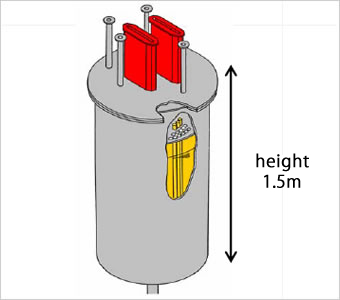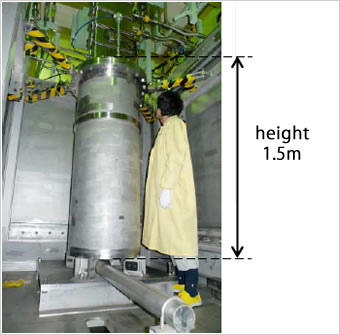STACY, the present apparatus
◎ Purpose of the facility
The objective of the experiments conducted with STACY has been to establish a database on the criticality safety of the solution fuel treated in fuel reprocessing plants and other fuel cycle facilities.
◎ R&D activities
Nuclear facilities where solution fuel is treated need to be designed considering criticality safety. Criticality safety research has been conducted with STACY since 1995. The research activities conducted for solution fuel systems were completed in the fiscal year of 2010. The license application for the modification of STACY, required for continuing research activities, was made in February 2011.
◎ Contributions
・Contributions to the termination of the JCO criticality accident
The knowledge and experience gained through the STACY experiments contributed to the termination of the criticality accident that occurred at the JCO uranium fuel fabrication plant in 1999, as well as to its post-accident investigations. The criticality and subcriticality of the tank where the accident had occurred were calculated under conditions with or without its cooling-water jacket, and, thus, contributed to the termination of the accident.
・Contributions to safety design and safety review
A newly evaluated handbook on criticality safety based on the STACY experiments is expected to be utilized for safety design and safety assessment of nuclear facilities, where solution fuel is treated.

A diagram of the present STACY core tank

External appearance of the core tank
◎ Major specifications:
| Name | STACY (Static Experiment Critical Facility) |
| Initial criticality | February 23, 1995 |
| Number of operations | 644 (as of November 2010) |
| Dimensions | diameter 0.6 m × height 1.5 m (600-mm-diameter cylindrical core tank) diameter 0.8 m × height 1.5 m (800-mm-diameter cylindrical core tank) width 0.7 m × thickness 0.3 m × height 1.5 m (280-mm-thick slab core tank) |
| Fuel type | Uranyl nitrate solution, Uranium dioxide fuel pin |
| Maximum thermal power | 200 W (about a millionth part or less of the thermal power of a commercial nuclear power plant) |
| Maximum excess reactivity | 0.8$ ※Unit of reactivity, which is an index for expressing divergence from a critical condition. A sudden increase of fission chain reaction and a power burst, both not controlled by operators, are experienced when reactivity goes over 1$ (Research reactors such as TRACY with an excess reactivity exceeding 1$ must have self-regulating characteristics of reactor power). |
| Features | STACY and TRACY are unique critical assemblies in the world using low-enriched uranyl nitrate solution as a fuel, which is treated in commercial reprocessing plants. |







